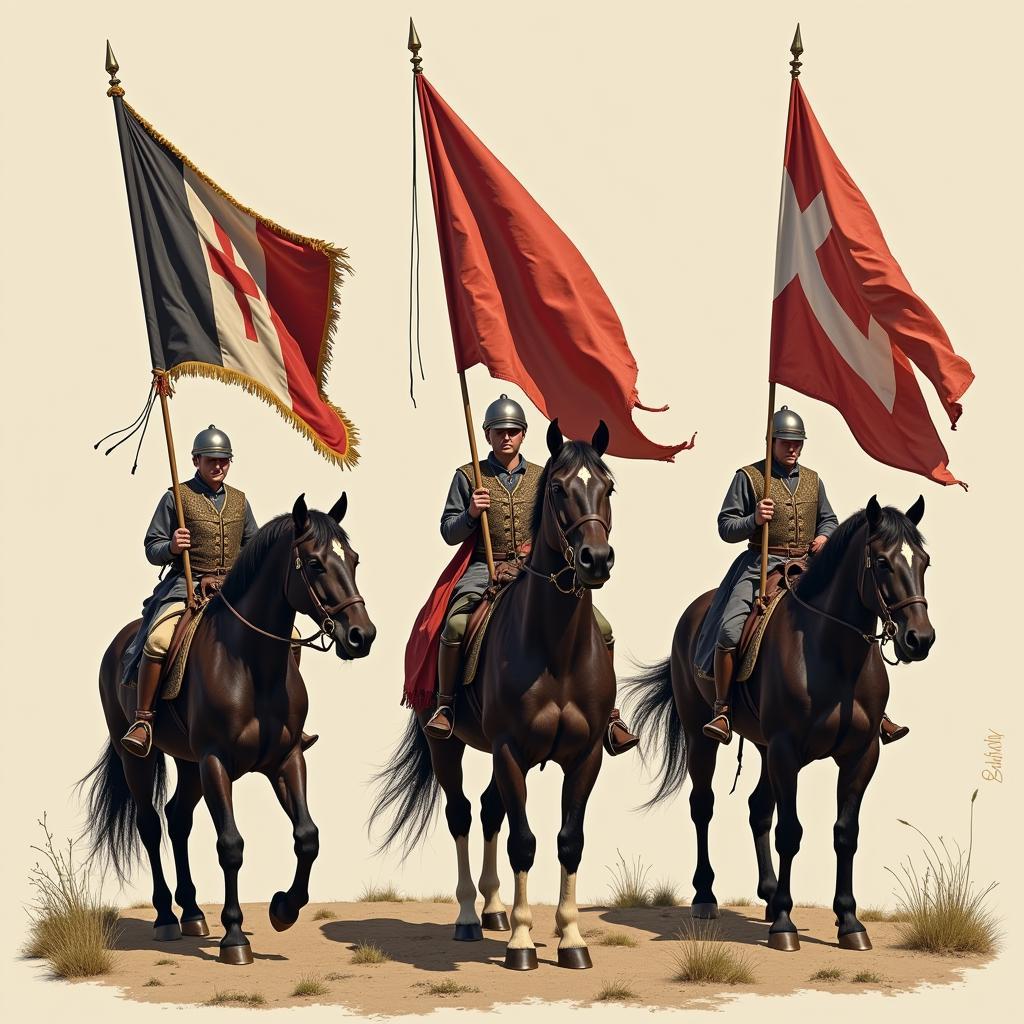Banner Horses, often depicted in historical artwork and literature, evoke a sense of grandeur and power. They represent a significant part of equine history, symbolizing strength, courage, and often, leadership. But what exactly constitutes a banner horse, and what makes them so captivating? This article delves into the fascinating world of banner horses, exploring their roles, significance, and the enduring allure they hold for horse enthusiasts and history buffs alike. We’ll examine the responsibilities these magnificent animals carried, the breeds typically chosen for the task, and the training involved in preparing them for their important duties. After the introduction, you can find some excellent horse birthday supplies on our website.
The Role of the Banner Horse in History
Throughout history, banner horses played a crucial role in warfare, ceremonies, and displays of power. Their primary function was to carry the banners, standards, or flags of armies, noble houses, or even nations. Imagine the battlefield chaos, the clash of steel, and amidst it all, a magnificent horse, steadfast and proud, carrying the symbol of hope and allegiance for the entire army. These animals were not merely beasts of burden; they were symbols of pride, inspiring troops and instilling fear in the enemy. Their presence could bolster morale, signify the leader’s position, and serve as a rallying point in the heat of battle.
Banner horses were also prominent in ceremonial processions and parades, adding a touch of majesty and spectacle to the occasion. Their elegant bearing and meticulously groomed appearance further emphasized the importance of the event and the status of those they represented. They were often adorned with elaborate trappings, reflecting the wealth and prestige of their owners.
Breeds Chosen for Banner Duty
Certain breeds were favored for banner duty due to their temperament, strength, and stature. Breeds like Friesians, Andalusians, and Percherons were often chosen for their imposing size, impressive appearance, and calm demeanor. These breeds possessed the physical and mental attributes necessary to remain composed amidst the clamor of battle or the excitement of a grand procession. Their strength was essential for carrying the weight of the banner and its pole, while their calm temperament ensured they would not be easily spooked by loud noises or sudden movements.
 Banner Horse Breeds: Friesian, Andalusian, and Percheron Horses
Banner Horse Breeds: Friesian, Andalusian, and Percheron Horses
Training a Banner Horse: Patience and Precision
Training a banner horse was a meticulous process requiring patience, skill, and a deep understanding of equine behavior. These animals needed to be desensitized to the sounds and sights of battle, the fluttering of the banner in the wind, and the presence of large crowds. The training often began at a young age, gradually introducing the horse to different stimuli and rewarding calm behavior. Over time, the horse learned to associate the banner and its associated equipment with positive experiences, building trust and confidence in its handler. You might also be interested in our selection of horse balloons.
Imagine the gentle, yet firm hand of the trainer, guiding the horse through increasingly complex maneuvers. The horse, with growing confidence, learns to carry the banner with grace and pride. This intricate process not only prepared the horse for its duties but also forged a strong bond between horse and handler.
The Enduring Legacy of the Banner Horse
While the practical use of banner horses has diminished in modern times, their symbolic importance remains. They continue to appear in historical reenactments, films, and artwork, reminding us of a time when these magnificent creatures played a vital role in human history. Their image continues to evoke feelings of awe and admiration, a testament to their enduring legacy.
 Banner Horse in a Medieval Battle Scene
Banner Horse in a Medieval Battle Scene
What is the historical significance of a banner horse?
A banner horse carried flags and banners in battles and ceremonies, symbolizing power, leadership, and morale.
Which horse breeds were commonly used as banner horses?
Breeds like Friesians, Andalusians, and Percherons were favored due to their size, appearance, and calm temperament.
How were banner horses trained?
Training involved desensitization to noise and crowds, gradually introducing the banner and rewarding calm behavior.
Conclusion
The banner horse, a symbol of strength and nobility, holds a unique place in equine history. From the chaos of the battlefield to the grandeur of ceremonial processions, these magnificent animals played a vital role in shaping human events. Understanding their history allows us to appreciate the enduring legacy of these remarkable creatures and the bond they shared with their human counterparts. For more equestrian-themed party ideas, check out our recommendations for horse birthday parties near me. The banner horse remains a powerful symbol, reminding us of the courage, loyalty, and majesty of the horse throughout history.
FAQ
- What is a banner horse? A horse trained to carry a banner in battles or ceremonies.
- Why were certain breeds preferred for this role? Their size, temperament, and strength made them suitable.
- What was the training process like? It involved gradual desensitization and positive reinforcement.
- Are banner horses still used today? Primarily in historical reenactments and cultural events.
- What does the banner horse symbolize? Strength, leadership, and morale.
- Where can I find more information about horses? Check out our horse cutout page for fun ideas.
- Are there toys related to horses and dragons? Yes, you can find some interesting dragon horse toys.
When you need support, please contact Phone Number: 0772127271, Email: [email protected] Or come to the address: QGM2+WX2, Vị Trung, Vị Thuỷ, Hậu Giang, Việt Nam. We have a 24/7 customer care team.